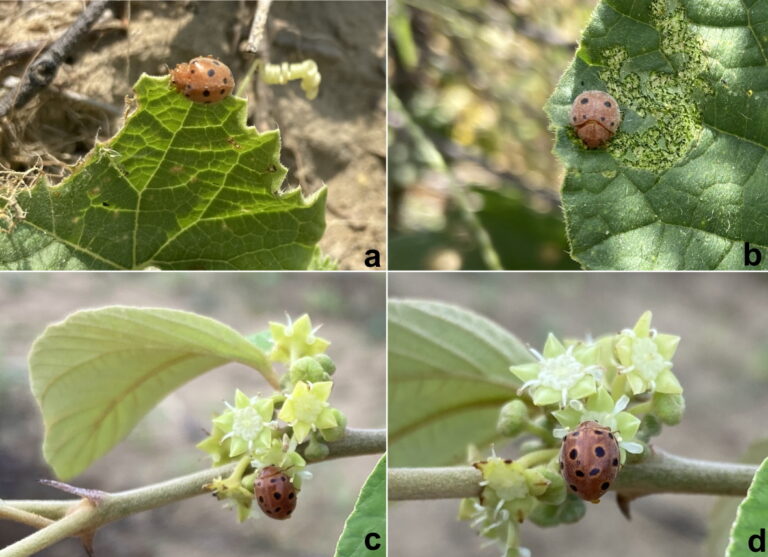
Chnootriba elaterii (Rossi) (=Henosepilachna elaterii (Rossi)), commonly known as melon ladybird, is distributed in Africa, Madagascar, the Middle East, and South Europe, and is mainly a pest of melons, cucumber, other cucurbits, and lettuce (CABI 2020). It was originally described as Coccinella elaterii by Rossi (1894). Fürsch (1964) erected the subgenus Henosepilachna (Elateria) with ‘Coccinella elaterii P. Rossi’ as the type species. In the World Catalogue of Epilachninae by Jadwiszczak & Wegrzynowicz (2003), it was listed as Henosepilachna elaterii and Pakistan from the Indian Subcontinent was included in its distribution range. Tomaszewska & Szawaryn (2016) synonymized Henosepilachna (Elateria) with Chnootriba Chevrolat in their generic revision of Epilachnini. They omitted to list the Indian subcontinent in the distribution range of the genus Chnootriba. They seem to have missed the record of C. elaterii published earlier as ‘Epilachna chrysomelina orientalis Zimm.’ from Rajasthan, northwestern India, by Kapur & Bhaumik (1966). It was originally described as Epilachna elaterii orientalis by Zimmermann (1934) and later synonymized with H. elaterii by Jadwiszczak & Wegrzynowicz (2003). Kapur & Bhaumik (1966) also mentioned its occasional occurrence in northern India. Specimens from Uttar Pradesh and Gujarat (in the collections of Zoological Survey of India, Kolkata, and material received for identification) also have been examined as part of the ongoing studies on Indian Coccinellidae. It is also known from Punjab and Khyber Pakhtunkhwa in Pakistan (Rehman et al. 2018; Bodlah et al. 2021). The distribution of C. elaterii remains to be mapped in India and systematic collections are lacking from many parts of India. Here, we report two economically important host plants of C. elaterii from Rajasthan for the first time based on field surveillance data for pests of crops.
The specimens were collected on two economically important and widely cultivated host plants, Cucumis melo var. callosus (Rottler) Cogn. (Cucurbitaceae), perhaps a synonym of Cucumis melo L. (John et al. 2012) (Fig. 2 a,b) and Indian Jujube/ber (Ziziphus mauritiana Lam., Rhamnaceae) (Fig. 2 c,d). Larvae and adults were collected on these host plants from Barmer District, Rajasthan, India, in September 2023 during routine surveillance for pest damage on various crops. The adult (Fig. 1) is yellowish-orange with black elytral spots characteristic in having distinct yellowish-orange halos and arranged in a 2-2-1-1 pattern on each elytron. The more common host, Cucumis melo var. callosus is known as mango melon, snap melon, small gourd and wild musk melon (Vernacular names: Kachri, Phoot Kakdi) and a non-desertic form of musk melon (Cucumis melo). It is a drought-hardy vegetable of the Indian Thar Desert widely consumed by the local people of the arid region of Rajasthan as a fresh fruit or as value-added products. Indian Jujube is also commonly cultivated as an arid zone fruit crop in Rajasthan and it is a new host record for C. elaterii. The nature of damage on these hosts is characteristic of phytophagous coccinellids with the larvae and adults feeding by scraping away the epidermis leading to skeletonizing and withering of the leaves. The host plants recorded from the Indian subcontinent until now include water melon from India (Kapur & Bhaumik, 1966), cucumber and bottle gourd from Pakistan (Rehman et al. 2015).
Due to the near total absence of literature records of this species from India, we consider this a minor pest that does not require intensive surveillance. On the other hand, the major reason for the availability of very few specimens of C. elaterii in Indian repositories is most likely the lack of systematic collection surveys for the documentation of economically important insect fauna associated with crops, with particular reference to the arid, inhospitable deserts of northwestern India.
Bodlah MA, Bodlah I, Rasheed MT, Fareen AGE, Ikram K, Iqbal Z, Zada R. 2021. Coccinellidae beetles (Coleoptera) fauna of district Layyah (Punjab), Pakistan. Asian Journal of Agriculture and Biology, 2021(1): 1-8. https://doi.org/10.35495/ajab.2020.05.299
CABI. 2020. PlantwisePlus Knowledge Bank – Technical Factsheet, Henosepilachna elaterii (melon (ladybird) beetle). https://doi.org/10.1079/pwkb.species.21504
Fürsch H. 1964. Die Arten der Verwandtschaftsgruppe Henosepilachna elaterii (Rossi) (=E. chrysomelina auct.) (Coleoptera, Coccinellidae). Reichenbachia, 3: 181–208.
Jadwiszczak AS, Wegrzynowicz P. 2003. World Catalogue of Coccinellidae. Part I - Epilachninae. Mantis: Olsztyn, Poland. 264 pp.
John KJ, Scariah S, Nissar VAM, Latha M, Gopalakrishnan S, Yadav SR, Bhat KV. 2013. On the occurrence, distribution, taxonomy and genepool relationship of Cucumis callosus (Rottler) Cogn., the wild progenitor of Cucumis melo L. from India. Genetic Resources and Crop Evolution, 60: 1037–1046. https://doi.org/10.1007/s10722-012-9899-2
Kapur AP, Bhaumik AR. 1966. A note on the lady-bird beetles (Coleoptera: Coccinellidae) from Rajasthan with first record of Bulaea lichatschovi (Hummel) from India. Records of the Indian Museum, 59(4): 445-448. https://doi.org/10.26515/rzsi/v59/i4/1961/161590
Rehman A, Awan ZR, Shah AH, Khan J, Khan, FN. 2018. Bionomics of ladybird beetles in district Bannu of Khyber Pakhtunkhwa, Pakistan. FUUAST Journal of Biology, 8(2): 249-256. https://fuuastjb.org/index.php/fuuastjb/article/view/190/176
Rossi P. 1794. Mantissa insectorum, exhibens species nuper in Etruria collectas, adiectis faunae etruscae illustrationibus, ac emendationibus. Volume 2. Prosperi: Pisa, Italy. 154 pp. https://www.biodiversitylibrary.org/page/33475022
Tomaszewska W, Szawaryn K. 2016. Epilachnini (Coleoptera: Coccinellidae)—A revision of the world genera. Journal of Insect Science, 16(1): 101. https://doi.org/10.1093/jisesa/iew082

Fig. 1. Chnootribae elaterii, dorsal view, specimen NRCB-CE-2.

Fig. 2. Melon ladybird feeding on: (a, b) wild musk melon; (c, d) Indian Jujube.